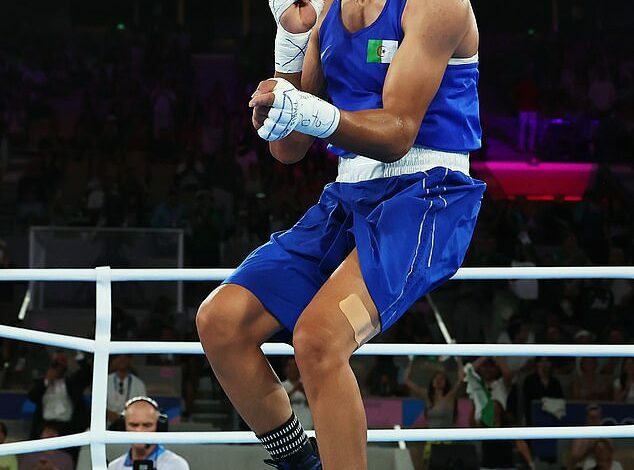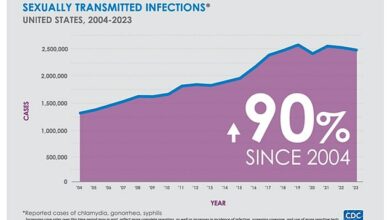Imane Khelif’s health is at the center of controversy over boxing at the 2024 Olympics – here’s what we think of her female fighters








The controversy surrounding Olympic boxer Imane Khelif grew even bigger tonight after she defeated a Thai woman in a landslide to advance to the final.
There have been calls to ban the 1.78m Khelif, 25 years old and one win shy of Olympic gold, from competing, suggesting she is not biologically female.
She is not transgender – there are photos of her as a little girl – and according to Olympic organizers, the Algerian has passed all gender eligibility checks.
However, last year Khelif was disqualified from the world championships by the Russian governing body IBA after she failed a gender test just before she was due to compete for a gold medal.
Some health experts believe she may have a disorder of sex development (DSD), an umbrella term for individuals with a group of conditions in which their reproductive anatomy does not conform to the typical definition of male or female.
Khelif denies this.
DailyMail.com spoke to two women born with DSDs — and to doctors — about whether they think Khelif has an unfair advantage over her female opponents.

Imane Khelif celebrates her victory over Thai boxer Janjaem Suwannapheng today

Khelif faces controversy over her candidacy in women’s boxing
Hannah Twigg is an intersex woman from the United Kingdom who suffers from a condition called Complete Androgen Insensitivity Syndrome (CAIS).
This means that although she has the XY chromosomes of a male, her body does not respond to testosterone because of a genetic mutation.
As a result, she has developed feminine characteristics, as testosterone has no effect on her sexual development.
Ms Twigg said: ‘I was on a lot of sports teams in high school and played myself.
‘[But] I have never felt that my condition gave me an advantage or disadvantage in sports.’
She added: “I would like to take this opportunity to say that Imane Khelif does not owe anyone an explanation for her gender and identity.”
Because testosterone is not acting on her body, this means she has not experienced the increase in muscle mass that men experience during puberty.
After puberty, men have about 40 to 50 percent more muscle mass than women.
However, some experts claim that Khelif may have another condition called 5-Alpha-Reductase Deficiency (5-ARD).
In this case, an individual is biologically male – with XY chromosomes – but his body fails to respond to a crucial hormone in the womb, leading to the development of a vagina or indeterminate external genitalia.
However, inside they have undescended testicles, which begin to release testosterone once a person reaches puberty. This leads to the development of male characteristics, including an increase in muscle mass.
South African middle-distance runner Caster Semenya was previously diagnosed with the condition, which led to her being disqualified from athletics competitions due to her elevated testosterone levels.
It is estimated that approximately one to two in every 100 people in the US are born with an intersex gender, or DSD.


Intersex women have defended Khelif, saying she should be allowed to compete in her category because she is a woman. Pictured on the left is Alyssa Ball, an activist for the intersex community, and on the right is Hannah Twigg, an intersex woman from the UK who is raising awareness about the condition.

Khelif was forced to speak out earlier this week, calling on boxing fans to stop bullying the athletes

Khelif, who was registered as female at birth, has been at the centre of a gender row after the IBA disqualified her from the world championships last year. She is pictured at the Paris Olympics
Alyssa Ball, who is also intersex and campaigns for awareness of the condition, told DailyMail.com: ‘I feel quite emotionally drained talking about this topic.
‘As an intersexual person, I naturally think she should be allowed to participate.
“Whatever ‘advantages’ she has, they are comparable to those of anyone else who is born with a body shape best suited for any sport.”
However, Dr Tommy Lundberg, a lecturer in physiology at Sweden’s Karolinska Institute, disagreed, arguing that she probably had a biological advantage because she had probably gone through male puberty.
He said: ‘If Khelif is indeed on 5-ARD, then that would be considered male development during puberty and therefore an advantage.
‘Being male is not a talent and should not be rewarded more than being female.
“Including athletes with male performance advantages in women’s sports violates the very important principles of fair and safe competition for female athletes.”
In tonight’s match, Khelif defeated her rival Janjaem Suwannapheng after overpowering the brave opponent and delivering harder blows, eventually winning by unanimous decision.

The testosterone limit rules had previously been brought into sharp focus by Caster Semenya, who was banned from women’s athletics competitions after she was found to have elevated testosterone levels.
She was cheered by a noisy Algerian crowd, who were already chanting ‘Imane’ before their boxer entered the arena.
After winning, she skipped victoriously around the arena before leaving to loud cheers ahead of her gold medal match on Friday.
Fiona McAnena, who works with scientists who research sex differences and is director of the UK women’s sport charity Sex Matters, also said she was likely at an advantage.
She said: It is not the fault of these young people that they have a congenital defect. [developmental] condition and are registered as female when their chromosomes are male. This can be a shocking, surprising and even traumatic thing to find out.
But apart from that, women’s sports are meant for people who have a female advantage and not a male advantage.
“If athletes have a male advantage and have gone through male puberty, then they do not belong in women’s sports.”
Khelif’s condition has not been made public. Experts can only speculate on whether she has a condition, and if so, what it is.
But a recent change in the International Olympic Committee’s (IOC) statement suggests she may be intersex.
On August 3, they updated a statement saying “this is not a Discrimination in Sexual Development issue” to “this is not a transgender issue.”
Khelif herself has said that she is a woman and has promised to continue competing.
In a statement, she said: “I am sending my message to all people around the world to adhere to the Olympic principles, as per the Olympic Charter, and to avoid bullying of athletes, as this has a major impact.
“It can destroy people, kill people’s thinking and spirit, and divide people.”
She previously dismissed the decision to ban her from the IBA competition as a “conspiracy” to prevent an Algerian from winning.
In Khelif’s native Algeria, there are strict anti-LGBT laws and society does not tolerate transgender people.
The IOC interprets someone’s gender literally based on what is stated in the passport.
They also organise the women’s boxing competition, despite a separate dispute with the IBA, which was barred from involvement.
However, in other categories, such as swimming, the federation reserves the right to test athletes if there are concerns they may have a biological advantage.
Experts suggest that the same thing should happen in boxing. They say that a blood test can determine whether someone has gone through male puberty. This test can show higher testosterone levels.




